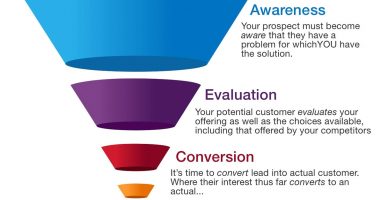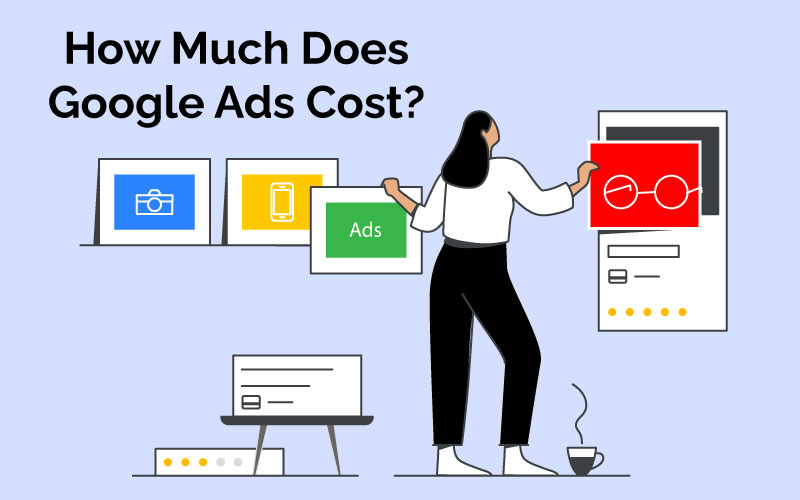
Table of Contents
- Introduction
- Factors That Influence The Cost Of Google Ads
- How Does The Google Ads Auction System Work?
- How Is Your Google Ads Budget Spent?
- How Keywords Influence The CPC Of Google Ads
- Google Ads Cost Per Click For Different Industries
- Leveraging Long-Tail Keywords To Keep CPC Low
And Conversions High - How Much Do Businesses (On Average) Spend On Google
Ads? - Additional Costs Associated With Google Ads
- Conclusion
Introduction
The simple answer to the above question is: it depends.
If you have read our other posts about Facebook and Instagram advertising costs, you may already know that when it comes to digital advertising, there is no one size fits all cost estimate.
Google Ads is no exception. Sure, these work on a completely different principle than social media advertising. However, Google Ads are still highly customizable which means the cost of Google Ads will vary for different businesses.
With that said, knowing the average cost per click across industries is a good place to start understanding what the cost of Google Ads may look like for your business.
With Google Ads, you can show your advertisements in the search results, known as the search network, and as display ads on the Google AdSense network. The average cost per click for the search network, across industries, is $2.69. On the other hand, the average cost per click for the display network, across industries, is $0.63.
This cost can vary dramatically between different industries. For highly competitive industries like legal services, the cost per click for the search network is, on average, higher than $6. On the other hand, for businesses operating in the travel and hospitality industry, this cost per click may be as low as $1.53.
This information makes one thing clear, knowing the average cost per click for Google Ads does not really provide any true insight into what kind of cost you will incur.
It is also worth noting that the industry you are operating in is just one of the many factors that influence the cost that a business has to pay for each click that comes through Google Ads.
What are the other factors?
Let’s find out:
Factors That Influence The Cost Of Google Ads
Let’s look at all the known factors that influence the cost you will have to pay for a Google Ads click:
Industry
This has already been partially covered. However, the influence of the industry on the cost per click is so high that it deserves a second consecutive mention. This means, if you are operating in a highly competitive industry, you must be prepared to pay a high cost per click for your Google Ads campaign. This will in turn mean that you may need a bigger budget to get results out of your efforts on Google Ads.
With that said, if you are paying a high CPC, it also often means that you are closing high ticket clients. For instance, in the marketing service industry, the ticket size for a client usually starts at around $1000 and may go up to hundreds of thousands of dollars.
This means, even if you are paying, say, $50 for a click, and your average ticket value is $10,000, it should not be a problem, as long as you are able to secure conversions.
Choice Of Keywords
As we will learn in the upcoming sections, Google search ads work by letting advertisers select the keywords for which their ads will be displayed. Within each industry, regardless of the level of competition within the industry, there are keywords that are widely targeted and thus, enjoy strong competition. Bids for such highly competitive keywords are usually higher. Meaning, if you are targeting a highly desired keyword in your industry, you may end up paying an unusually high cost for every click.
On the other hand, if you manage to find a highly relevant keyword that isn’t being targeted by your competition and still has a decent search volume, then you can unlock high conversions while paying a very low cost per click.
Customer Lifecycle
The modern consumer does not view ads and make purchases. This is especially true for products and services that have a high ticket size associated with them.
Today, consumers take more time to move closer to the purchase decision. Especially in the case of high ticket products and services, customers often need multiple exposures to advertising and marketing messaging before they convert into paying customers.
From an advertising perspective, this may mean that a customer may come across your ads multiple times, click on them several times, and repeatedly visit your website before finally making a purchase decision. The average amount of time that a customer takes to arrive at the purchase decision can thus have a direct influence over the cost you pay for Google Ads.
Online Trends
The fact that online trends influence the cost of advertising online should not come as a surprise.
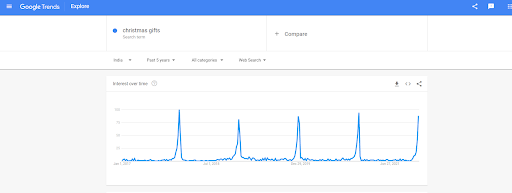
There are two types of trends that influence the cost of advertising. One is a global, non-periodical trend, such as the recent pandemic. During the peak months of global lockdowns, some industries saw the average cost per click dropping and the average click through rates increasing. Similarly, there were other industries where the cost per click suddenly shot up, and the click through ratio tanked.
For instance, the average click through rate for the apparel industry was below the 3% mark on March 9th but shot up beyond 4% by mid-April. The average CPC also dropped from nearly $1.50 to below $0.90 during the same period.
Now, it is obvious that you cannot control a trend like global lockdowns, or how they influence the performance and cost of your ad campaigns.
The other type of trend that influences the cost of Google Ads is seasonal trends. For instance, there is more intense ecommerce activity happening on the web during the last three months of the year. That’s why, during this time, the average cost per click goes up across different industries.
Understanding the above-mentioned factors helps us accomplish two things. One, it helps us make better, more efficient advertising plans and schedules, helping us avoid times and actions that may drive up the cost payable for every click. Two, they give us a realistic picture of what one may have to spend on advertising on the Google Ads platform.
However, in order to truly make the most of your Google Ads budget and make sure you aren’t paying an unusually high cost per click, developing an understanding of how the Google Ads auction system works is critical.
This is what the next section of the article is dedicated to. Let us jump right in.
How Does The Google Ads Auction System Work?
To begin with, let’s understand the logic behind the Google Ads auction system. Let’s assume an example where a user goes on to the Google search engine and enters a search query. Once this happens, Google checks if advertisers on the Google Ads platform are bidding for that keyword/search query.
If Google finds multiple advertisers bidding for those keywords, it uses an auction system to determine which advertisers’ ads will be displayed in the results. The auction system is also used to determine the rank of the ad displayed in the search results.
Let’s find out how exactly all of this is done.
The Ad Rank Calculation
Google decides an ad’s rank, or even whether or not it will be displayed for a specific search query based on two primary factors:
Maximum Bid
As the term suggests, this is the maximum amount that an advertiser has agreed to pay for each click on their ad. While it is true that a higher bid does improve your chances of placing your ad higher in the search results, since it is not the only factor, things are a little more complicated.
Quality Score
The quality score of an ad or ad group helps Google decide its relevance to the keyword being targeted. Google places such a high value on the quality score because it wants to provide a delightful experience to its users. With no option but to show ads to its users, Google has to ensure these ads are relevant to their search queries to make sure the quality of user experience is not brought down because of the ads.
Google considers a variety of factors while determining the quality score of an ad. These include:
- The relevance of targeted keywords and the ad groups.
- The relevance of the ad copy to the keywords.
- Historical ad account performance.
- Click through ratio.
- Quality and relevance of the landing page associated with the ad.
Quality score is actually so important that a high enough quality score can still help advertisers secure their desired ad rank, even if their bid is not the highest. Similarly, quality score is also a critical component used by Google to decide the actual cost per click payable by a specific advertiser.
However, before we understand how that cost is calculated, let’s look at the equation that determines your ad rank. Here’s what it looks like:
Ad Rank = Maximum Bid * Quality Score
The advertisers whose bid and quality score multiply to give the biggest numbers are given the best ad ranks.
Once the ad rank is calculated, Google is able to calculate the actual cost per click payable by specific advertisers.
The Actual CPC Calculation
The formula that Google uses to calculate actual CPC paid by an advertiser looks something like this:
Actual CPC = Ad Rank/Quality Score + $0.01
Because of the way this formula is designed, the field is leveled for different players on the Google Ads platform. This is important because this means that advertisers with small budgets have an almost equal chance of securing conversions as compared to their competitors that are backed by enormous advertising budgets.
This happens because the ad rank and the actual CPC paid by advertisers are both calculated based on the Quality Score. This means, even if your maximum bid is low but your quality score is high, your ad will be placed above a competitor who has placed a higher bid but doesn’t have a Quality Score that is as high as yours.
Understanding how your Google Ads CPC is decided and how the auction system of Google Ads work is one aspect of understanding what advertising on Google Ads will cost you. The other aspect is understanding how your budget is spent.
How Is Your Google Ads Budget Spent?
Let’s begin by understanding why knowing how your Google Ads budget is spent is important. The simple answer is that many advertisers who don’t understand this, end up spending their ad budget much quicker than they initially anticipate. Essentially, if you don’t understand how your ad budget is spent, you may end up spending your monthly ad budget in a matter of days. Not a desirable situation, right?
While Google does offer you tools to avoid such situations, like a tool that lets you set a monthly spend limit. However, such a tool would do little good in terms of ensuring your monthly budget actually stretches across the month.
By understanding how your budget is spent by Google Ads, it is possible for you to exert the kind of control that lets you ensure your budget goes a long way.
With the “why” out of the way, let’s understand the different aspects that play a role in how your Google Ads budget is spent:
Daily Budgets
Daily budgets are exactly what the term suggests. It defines the maximum amount that Google Ads will spend in a single day. If this amount is spent within the span of an hour, your ads will stay on pause for the rest of the day.
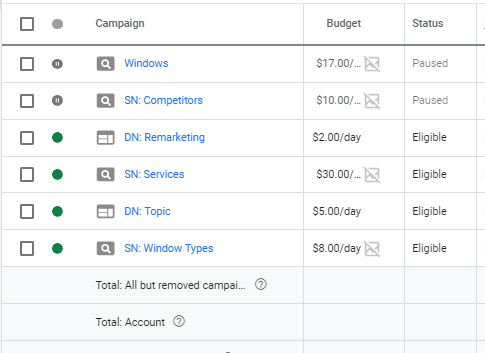
A daily budget can also be used as a tool to ensure you have the right expectations with your monthly budget. By determining a daily budget, and multiplying it with the number of days in a month when you will advertise, you can come up with a realistic monthly budget.
To exert more control over your daily budget, you should divide it into different campaigns based on priority. Google lets you decide the daily budget for specific campaigns. So, let’s say your daily budget is $100 and you have two campaigns running. One is a conversion focused campaign and the other one is a brand awareness/nurturing campaign. If generating more revenue is a priority, you can allocate $70 to the conversion campaign and $30 to the brand awareness campaign.
In order to build a holistic view of how your daily budget is spent, it is also important to understand the relationship between cost per click and daily budget. Knowing the relationship between your CPC and your daily budget will also enable you to plan your daily budgets in alignment with your goals.
If, for instance, you have an ad with a CPC for $1 and your goal is to get 10 clicks on that ad every day, you can bid $1 and keep your daily budget for that ad limited to $10. In this example when your bid is $1, you will never pay more than $1 for a click.
Now that we have learned how daily budgets work, let’s look at a few ways you can maximize the results you get by spending your daily budgets.
Maximizing The Impact Of The Daily Budget
Device Targeting
Modern consumers have a variety of options available for accessing the web. Today, users are often found using multiple internet-connected devices at the same time. Another trend that has emerged is device usage preference. Not only does the preferred device vary across different age groups and geographical locations, but even individual users also prefer different devices for different activities on the web.

An over simplified example of the same is working exclusively on your laptop and using Instagram exclusively on your smartphone.
Brands must understand which devices are preferred by their target audience, or which devices their target audience prefers to use when looking up information or making purchases. With this information, you can target specific devices with specific advertisements.
It will further allow you to be more laser targeted towards an audience that is most likely to take the desired actions after they have clicked on your ad. Targeting specific devices will enable you to minimize clicks from users that are likely to click but not likely to engage with your landing page, helping you avoid unnecessary spending on clicks that don’t contribute towards results. In other words, targeting specific devices will enable you to use your daily budget more efficiently.
Geotargeting
Geotargeting, as the name suggests, refers to the ability to target specific locations with your advertisements. This ability is especially beneficial to local businesses or physical stores that are trying to use Google Ads to increase the footfall at their store. However, even bigger brands or brands that live on the web can use geotargeting to their advantage.
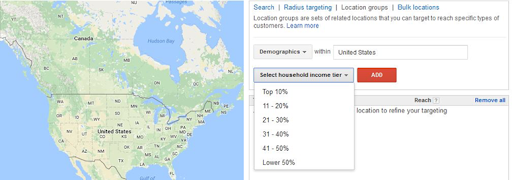
For instance, an online brand that sells jewelry can identify specific zip codes where residents have a relatively higher income and exclusively target those areas with their advertisements. Even if this brand shows their brand awareness ads in these areas, they can pretty much ensure that they are creating brand awareness in the minds of prospects that can actually afford their products.
Time Targeting
Time targeting or ad scheduling is another excellent feature of Google Ads that can be incredibly advantageous to local businesses and physical stores. If your store only operates during specific hours, you can instruct Google Ads to only show your ads during your operational hours. This way, you will not be wasting precious marketing dollars when generating clicks is pointless.
Ad scheduling is a truly advanced feature that offers incredible flexibility. Advertisers can set different schedules for specific days of the week. If, for instance, your store opens for a longer time on weekends, you can specify Google to run ads for a longer, pre-defined period of time.
So far, we have discussed how daily budgets, ad relevance, and targeting settings influence the cost per click for Google Ads. This just leaves out the one factor that has the biggest influence over the cost per click that you will have to pay- the keyword.
We have already discussed how the cost per click varies for different industries. This is determined by looking at the cost of industry-specific keywords, such as ‘advocate’ or ‘insurance’. However, even within specific industries, there can be hundreds, even thousands of keywords that are relevant to the businesses operating within those industries. The cost per click for all of those keywords varies on a few factors.
Let’s learn about them in the next section.
How Keywords Influence The CPC Of Google Ads
Keywords are widely considered the key deciding factor in determining the actual cost per click for your Google Ads. Even within specific industries, different keywords command different price tags for advertisers. The value of every keyword mainly depends on two factors:
Commercial Intent
For anyone dealing with any kind of marketing activity related to search engines, understanding keyword intent is absolutely critical. Simply put, the intent behind a keyword is the purpose with which the search query is formed.
From an advertising point of view, there are two main types of keyword intent that you need to know- informational and commercial.
A simple example can be “black hoodies”. If a user looks up this search term, they are most likely interested in purchasing a black hoodie, not learning more about them. This makes “black hoodies” a keyword with strong commercial intent. A counterexample can be the keyword “email marketing”. Anyone searching for this query is most likely looking for more information about email marketing and probably not looking to purchase an email marketing software. That’s why the term “email marketing” has an informational intent behind it.
For advertisers, understanding keyword intent does two things.
One, it helps them understand and justify the cost associated with every click for that keyword. Keywords that have a strong commercial intent associated with them have a higher cost per click associated with them.
Two, it helps them write the right kind of ad copies and make the relevant landing pages to support their ads. To learn what kind of intent is associated with a specific keyword, all you need to do is use Google to search that term. Then, you can simply observe the top ranking results and find out what kind of intent does Google associates with that keyword. Here are the search results for our “black hoodies” and “email marketing” examples:
Competition
The competition around a keyword, meaning the number of advertisers targeting a particular keyword, is one of the biggest influences on the cost per click associated with that keyword.
Even if you are operating in a low-competition industry, there may be a certain set of keywords that are desired by a large number of advertisers operating in your industry. The cost per click for such keywords may be much higher than your industry’s average.
With that said, understanding industry averages can provide valuable insight into the cost you can expect to incur for your Google Ads campaigns.
Google Ads Cost Per Click For Different Industries
Since we are talking about the relationship between keywords and CPC, it is best to look at industry-specific keyword categories to understand the kind of CPC that is considered ‘normal’ in different industries.
Bear in mind that we will be discussing keyword categories that represent different industries and not the average CPC for actual keywords. Without further delay, let’s look at the numbers:
Insurance: $54.91
Loans: $44.28
Lawyer: $42.51
Software: $35.29
Rehab: $33.59
As you can see, all of these average CPC rates are much higher than the $1 to $2 average CPC of Google Ads. This is because the list contains some of the most expensive keyword categories.
It is also worth noting that since these are keyword categories and not actual keywords, the actual keywords, depending on the words you associate with the above-mentioned categories, may command a higher or lower CPC than the average mentioned in the list. For instance, in the “insurance” category, the keyword “motor insurance” may command a lower CPC than the keyword “property insurance”, or vice versa.
With that said, it is important to relate the cost per click with the return on investment you expect to make. For instance, for businesses in the insurance industry, paying a cost per click of nearly $55 seems steep, until you look at the lifetime value that insurance companies get from their customers. In most cases, this runs into thousands of dollars. This means, even if 10 clicks generate a sale, and the average CPC paid by an insurance company is $55, then on average, the company closes a client worth thousands of dollars by spending $550. That’s not bad at all.
Leveraging Long-Tail Keywords To Keep CPC Low And Conversions High
The “motor insurance” and “property insurance” examples discussed above actually make up for a minuscule percentage of the actual keywords that users generally use on search engines.
A lot of users on Google (and other search engines) tend to use long-tail keywords to try to get results that they truly want to see. This is, in fact, partly the reason behind Google’s recently increased focus on the keyword intent.
It is safe to say that long-tail keywords make up for a significant percentage of search terms used on search engines. The good news is, targeting long-tail keywords with your ads is also much, much cheaper than targeting broad match keywords like “motor insurance”. Meaning, if you cannot afford the CPC associated with “motor insurance”, you can instead target “motor insurance [location]”.
There is also the opportunity to target keywords that may not have an obviously strong commercial intent. Here’s a great example to explain this:
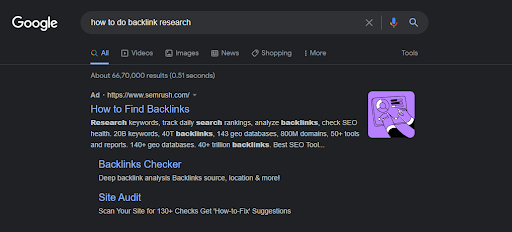
Here, the search query “how to do backlink research” is not really commercial. Users searching this term may simply be looking for information about backlinking. Yet, SEMrush, an SEO software, is running an ad on these keywords. This makes sense for a number of reasons:
- Since the intent behind the search term is not commercial, there is a good chance that SEMrush is paying a CPC that is significantly lower than the industry average. Despite this, they are getting somewhat relevant traffic from this ad, that is, of individuals that are interested in learning about SEO and backlinking.
- Finding and researching competitor backlinks is a big part of building backlinks that drive SEO results and doing that without SEO software is very difficult. In fact, if you are not an SEO veteran, it may be impossible to do backlink research without a specialized tool like SEMrush. Meaning, the information provided by SEMrush is simply aimed at guiding prospects to the conclusion that they need to purchase SEMrush.
Targeting this keyword also makes sense for SEO agencies. This is because backlinking is a complex marketing activity that many businesses are not able to tackle in-house. This is true especially in the case of small businesses that don’t have an in-house marketing team.
Meaning, if a marketing agency writes a guide to backlink building and runs an ad on this guide, they will simply be helping their prospects realize that they need professional help if they are going to do backlink building effectively.
This is just one of the many ways that marketers can innovate with their choice of keywords and pay a lower than average cost per click while still generating highly relevant traffic for their websites.
How Much Do Businesses (On Average) Spend On Google Ads?
Another good way of understanding how much Google Ads cost is to look at how much the other businesses are spending. In this section, however, we will limit our discussion to the average amounts spent by small businesses. The reason behind this is simple: large businesses in competitive industries, such as edtech, spend up to $40-$50 million on Google Ads.
If you are reading this guide, there is a good chance that you are indecisive about Google Ads and even when you take the plunge, it will not be with a budget that runs into tens of millions of dollars.
Small businesses generally spend anywhere between $5000 and $20,000 per month on Google Ads. However, not all of this money is given to the platform. There are a couple of associated costs that businesses may have to bear.
Additional Costs Associated With Google Ads
If, say, you plan on spending $5000 per month on Google ads, the major percentage of this money will be spent on the Google Ads platform. However, there are a few optional but (sometimes) important costs that you may need to factor into your budget. Whether or not you pay these costs depends entirely on your level of expertise, your desired goals, the availability of time, and the unique situation of your business.
These costs are:
PPC Management Software
While the Google Ads platform is certainly capable, it can also come off as a complex tool, especially for beginners. In fact, many believe that the perceived complexity associated with the Google Ads platform is one of the biggest barriers preventing more businesses from getting on the advertising platform, despite having the required budget.
How do we know this? Because there is an entire class of software being sold to address this problem. These software are known as PPC management software. Popular examples include Captivise, Opteo, and Adespresso.
These software can help you save time on planning and optimizing your Google Ads campaigns while also ensuring that you avoid costly mistakes. In other words, most PPC management software are designed to simplify specific aspects of operating different Google Ads campaigns.
Even if you are a seasoned marketer, a PPC management software can help you save a ton of time and effort. This time can then be used to focus on and improve core business activities. Most PPC Management software cost around $800 and $1000 on a monthly retainer.
PPC Management Agencies
While it is true that using Google Ads can be a technically intensive undertaking, the truth is that the platform is designed to enable just about anyone and everyone to advertise their business. Meaning, by spending a few weeks or months, almost anyone can learn how to use Google Ads.
However, if marketing is not the core competency of your business, spending time learning how to use Google Ads may not be a wise choice. Many business owners understand this and that’s why they enlist the help of marketing agencies that specialize in PPC marketing.
By simply being a little careful about picking your advertising partner, you can almost guarantee a positive ROI from your Google Ads budget. Think about it, when you work with an agency, someone that specializes with the Google Ads platform is taking care of your advertising efforts. If you choose carefully, you can even find someone that specializes in working with businesses similar to yours.
While enlisting the help of an agency is clearly the easier way to achieve success with Google Ads, it can be significantly more expensive than using a PPC Management Software. PPC management companies charge their clients anywhere between $500 to $5000 for every month of managing their Google Ads campaign. This cost is over and above your actual ads budget.
Some companies may offer their clients the option of paying a percentage of their ad budget. Typically, this charge is around 10% of the advertising budget. Meaning, if you plan on spending $1000 on Google Ads every month, the PPC management company will charge you $100 per month.
There’s another catch. While it is important for the PPC company’s business to drive success for their clients, even if they fail to deliver a positive ROI to you, you will be liable to pay them their monthly fee.
With that said, selecting a PPC company that will truly deliver success for your Google Ads campaign involves many considerations that go beyond their monthly fee. If you want to ensure your advertising dollars and agency fees aren’t going to waste, make sure you are considering the company’s overall experience, their experience with businesses in your industry, and their relationship with Google.
Conclusion
By now, it must be clear that there is no right answer to the question “how much does Google Ads cost?”. The actual cost that you, as an advertiser, will have to pay depends on an enormous variety of factors and industry averages are not a good enough point of reference.
Having said that, the reality is that almost any business can make Google Ads work for them, even if they don’t have a huge advertising budget. A little bit of innovation and paying attention to what Google likes can go a long way when it comes to Google Ads. Regardless of how big your competitors are, the Google Ads platform is designed to level the playing field. Once you understand that, you will have the conviction needed to secure success with Google Ads.

